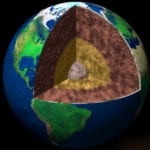 Travel
Travel  Travel
Travel  Creepy
Creepy 10 Haunted Places in Alabama
 History
History Top 10 Tragic Facts about England’s 9 Days Queen
 Food
Food 10 Weird Foods Inspired by Your Favorite Movies
 Religion
Religion 10 Mind-Blowing Claims and Messages Hidden in the Bible Code
 Facts
Facts 10 Things You Never Knew about the History of Gambling
 Weird Stuff
Weird Stuff 10 Cool and Creepy Facts about Collecting Tears
 Humans
Humans The Ten Most Lethal Gunslingers of the Old West
 Misconceptions
Misconceptions 10 Phony Myths and Urban Legends That Just Won’t Die
 History
History 10 Amazing Roman Epitaphs
 Travel
Travel Top 10 Religious Architectural Marvels
 Creepy
Creepy 10 Haunted Places in Alabama
 History
History Top 10 Tragic Facts about England’s 9 Days Queen
Who's Behind Listverse?

Jamie Frater
Head Editor
Jamie founded Listverse due to an insatiable desire to share fascinating, obscure, and bizarre facts. He has been a guest speaker on numerous national radio and television stations and is a five time published author.
More About Us Food
Food 10 Weird Foods Inspired by Your Favorite Movies
 Religion
Religion 10 Mind-Blowing Claims and Messages Hidden in the Bible Code
 Facts
Facts 10 Things You Never Knew about the History of Gambling
 Weird Stuff
Weird Stuff 10 Cool and Creepy Facts about Collecting Tears
 Humans
Humans The Ten Most Lethal Gunslingers of the Old West
 Misconceptions
Misconceptions 10 Phony Myths and Urban Legends That Just Won’t Die
 History
History 10 Amazing Roman Epitaphs
10 Discoveries That Change How You Picture The Ancient Earth
Modern science has learned a lot about Earth’s past, and researchers have uncovered some surprising details that go against everything we take for granted. Details like . . .
10Mammals’ Ancestors Ruled The Earth Before The Dinosaurs

Mammals and reptiles don’t look alike, but they do share a common ancestor. As they went their separate ways, reptiles such as the ancestors of dinosaurs became diapsids. The forefathers of today’s mammals became synapsids. That rivalry lasted for over 230 million years, and mammal-synapsids totally dominated dino-diapsids for the first half of that time.
Dimetrodon, for instance, a sail-backed mammal ancestor, was the dominant land carnivore of the Permian period. It measured 3.5 meters (11.5 ft) long and weighed 100–150 kilograms (220–330 lb). Its huge head and long fangs surging out of muddy swamp water was the last thing many animals—including other dimetrodons—ever knew.
The Permian period was brutal on the diapsids. They didn’t leave many fossils behind. We do know that some grew as large as 2 meters (6 ft), but most stayed small and avoided the ruling synapsids as best they could. Then came the “Great Dying.” Over 90 percent of all species went extinct at the end of the Permian period.
Synapsids had a really good niche, and some survived. These went on to become quite common. However, there was now more competition from the diaspids. The die-off had left enough opportunities for dino-diapsids to get established. Over millions of years, the two groups carried on the feud as each line evolved further. By the middle of the Triassic, synapsids were turning into modern mammals. Diapsids were becoming dinosaurs . . . not yet humungous ones, but big enough.
The first dinosaurs were as large as a typical modern dog. By the end of the Triassic period, some were 6 meters (20 ft) long. One group—ichthyosaurs—already ruled the seas. Then came another mass extinction, and dinosaurs inherited the land as well. This extinction ended the synapsid party once and for all, leaving only small modern mammals to foot the bill.
9No One Knows What Killed Off The Dinosaurs

The end-Cretaceous extinction went something like the following, according to the most commonly held theory from the 1980s to today. First, dinosaurs ruled the world. Then, a big asteroid crashed near modern-day Chicxulub, Mexico, sending Earth into a global winter. The age of dinosaurs ended, as 80 percent of Earth’s species perished. Then, mammals inherited the world. Ever since undeniable evidence showed an impact in the right place at the right time, researchers have accepted the explanation. Perhaps, they further reasoned, impacts had caused all of Earth’s mass extinctions.
Everybody spread out into the field, looking for more craters. They found plenty, but most couldn’t be linked to a mass extinction. And in the meantime, questions have been raised about the end-Cretaceous extinction and that asteroid impact. Such a massive wallop should have killed off a lot of life all over Earth. Instead, some species survived—even dinosaurs, which later evolved into birds.
Some explain this with a double whammy of the Chicxulub impact and contemporary extensive volcanic flooding from a region called the Deccan traps. The Deccan eruption, these experts say, made life difficult all over the world. Then along came the asteroid to deliver a coup de grace to the most stressed animal groups, including T. rex and its buddies.
It’s a good argument, but not everybody buys it. Others researchers say that they have found evidence of dinosaurs thriving right next to the Deccan volcano while it erupted, even nesting on its lava. These experts also say that at the end of the age of dinosaurs, Earth was hit by several big impactors—asteroids or comet fragments—over a short span of time. Chicxulub was in there, but the biggest one was Shiva, three times as big as Chicxulub. When Shiva hit our planet off the western coast of modern India, its impact was massive enough to change how plate tectonics operated in the area. The nearby Deccan eruption then went into overdrive, and a mass extinction followed.
So take your pick. Was it Chicxulub, Chixculub plus volcanism, or the Shiva space barrage plus volcanism that shut down the age of dinosaurs? No one knows for sure.
8It Can Rain Diamonds

You wouldn’t want to be there to catch them, though. This happens during a violent volcanic eruption.
Diamonds are crystals of pure carbon that take shape under intense heat and pressure in Earth’s deep interior. Nobody is quite sure how the carbon gets down that far in the first place, but everyone agrees that diamonds are very, very old.
Once formed, diamonds just hang out in the planet’s mantle. Plate tectonics may bring a continent rolling over them to scrape some up. As geologic time goes by, the oldest parts of all continents collect diamonds this way, sort of like ship keels collecting barnacles.
None of this helps us get rich, of course. In fact, diamonds can’t exist naturally on Earth’s surface—they turn into graphite. The only reason we have any is because very deeply rooted volcanic eruptions have blown them up here too fast for them to change over.
Here’s how it happens. An unusual type of molten mantle rock called kimberlite or lamproite starts moving upward from below the diamond-studded mantle layer. This happens very quickly because this magma is “fizzy”—it’s got a lot of carbon dioxide and water in it. The fast-rising kimberlite collects diamonds along the way, blasts through the overlying continent in a diamond pipe, and boom. It’s raining diamonds.
7Purple Oceans

Ocean water is largely transparent. The color you see depends on what’s in it—muddy brown or yellow near the coastline where a huge river is emptying into the sea, or grayish green further out thanks to seaweed and myriad tiny organisms.
However, we’re really just familiar with the uppermost areas of the ocean, which sunlight can penetrate. Here, plankton use light for photosynthesis. One of the byproducts of that process, in the sea just as on land, is oxygen. Today, this oxygen travels all through ocean water, even down into the cold, dark abyss. That’s because it dissolves really well in cold water and so can be carried by seafloor currents.
In a few spots, though, like some of Norway’s fjords, seawater stagnates. Too many nutrients pile up in it and use up all its oxygen. Little water critters must live, so the local food chain first switches over to nitrogen, and when that’s gone, to sulfur. A sulfur-based food chain puts a lot of hydrogen sulfide into the sea, which is bad news for most forms of marine life but wonderful for the little green and purple sulfur eaters. Oxygen is lethal to these sulfur-loving bacteria, but they thrive and color the water pink to purple wherever they find the right conditions. Today, you’ll find them in the Black Sea, as well as in a few fjords and lakes.
Where did they first come from? Well, they’re among Earth’s oldest inhabitants.
Pigments from little purple sulfur eaters have been found in 1.64-billion-year-old rock from what’s now northern Australia. Those bacteria were living just after Earth had lost its banded iron formations (BIFs), which stopped forming in the sea some two billion years ago. Geologists have long puzzled over why no more BIFs formed after that. The two main theories involve an oxygen-rich ocean or a stinky hydrogen sulfide brew.
The discovery of those pigments is a plus for hydrogen sulfide. It also means that the ancient sulfuric ocean was full of happy little sulfur eaters . . . and was therefore a lovely shade of purple.
But where did all that water come from in the first place?
6A Lot Of Earth’s Water Is Older Than The Solar System

The solar system formed out of a huge cloud of interstellar dust. Dust is dry. But some of the cloud’s hydrogen and oxygen could have combined into good old H2O. It would have been blown out of the inner solar system, though, when the Sun first lit up. The only place to find water after that would have been in the outer solar system or at the edges where comets orbit.
Scientists looked into this and figured that Earth’s oceans formed about one billion years after the planet took shape. This could explain the oceans with a combination of volcanic outgassing and the impacts of icy comets. The volcanoes would release what little water had gotten buried inside the Earth during its formation. The rest of the water would come in as comets bombarded us early in the new solar system’s life.
It’s a good story and has held up well through the years. However, it’s probably only partly right.
Researchers have just discovered that 30–50 percent of Earth’s water is older than the solar system. Interstellar ice was here, in other words, before the dust cloud that birthed our solar system. Those scientists used a relative dating method to show that up to half of the water in, among other things, your body is over 4.6 billion years old. They can’t give a precise date, but this ancient water could be almost as old as the universe.
5Life Might Have Come To Earth From Mars

Meteors blaze across the night sky or surprise us in broad daylight. These little fragments of asteroid or comet debris usually burn up in the atmosphere. If they do make it to the ground, they’re called meteorites.
In the 1980s, after the Viking missions to Mars, scientists were surprised to find that some meteorites apparently came here from the Red Planet. Today, NASA is pretty sure that they’ve got at least 124 chunks of Martian real estate on file. The Mars meteorites appear to be volcanic rock, and Mars does host the biggest known volcanoes in the solar system. However, not even the biggest eruption at Olympus Mons could have blown these rocks to Earth.
After a lot of detective work, some experts think that an impact ejected these 4.5-billion-year-old pieces of lava into space some 15 million years ago. They reached Earth about 13,000 years ago. Some of them show fossils, or at least proof that the rock formed in water that might once have hosted life.
That sounds unlikely, since these rocks used to be lava, but life finds a way. Today at Yellowstone, tiny organisms called extremophiles live in hot springs and in some of the rocks there. Tough little supervolcano-dwelling creatures like these could possibly survive the extremely harsh conditions on Mars. They could even live through an impact, if they were far enough inside a big rock slab. As for the fiery fall to Earth, scientists have done experiments that show endoliths would probably need only about 5 centimeters (2 in) of rock for a heat shield.
Of course, life on Earth is about four billion years old, and these Martian tourists are recent arrivals. But we haven’t found all the meteorites. These definitely got here, so other Martian meteorites could also have landed back when Earth was very young. Even if they didn’t bring us life-forms, Martian meteorites might have brought us the minerals needed to jump-start life on Earth.
4Early Earth Wasn’t Hellish

Geologists call Earth’s early years the Hadean period after Hades, often considered the ancient Greek counterpart to Hell. The heat of the Earth’s formation, according to theory, melted most of the planet, which then took a long time to form today’s relatively cool surface crust. Most material from Hadean Earth is gone now, thanks to weathering and plate tectonics. All that’s left are little crystals of the mineral zircon.
Zircon (zirconium silicate) makes pretty jewelry, but it’s also very useful to scientists for two reasons. First, it’s tough enough to survive the rough-and-tumble world of geology. You can erupt zircon from a volcano, crush it in a tectonic plate collision, or bury it under miles of sediment, and zircon just shrugs and grows another layer. Geologists will later come along and read those layers like a history book. Second, zircon contains a tiny bit of uranium—not enough to harm you, but just the right amount to do some precision scientific dating.
Researchers tested the oldest known zircon, which goes all the way back to the Hadean period. This mineral crystallized at a much cooler temperature than expected. Isotopes further showed that water and other conditions suitable for life could have been around when the crystal formed. Earth, 4.4 billion years ago, may well have had continents and oceans that were made of life-supporting water, not deadly molten lava.
However, Earth does have a core that’s made out of iron. This means the planet must have been hellish for at least a little while after it formed. It also means that you have to pay a lot for precious metals to go with your zircon gem, because . . .
3Gold And Platinum Fell To Earth’s Core

Metals like gold and platinum are rare on Earth today, but they’re common on some asteroids. Those asteroids formed out of the same dust cloud that Earth did. So why isn’t there lots of gold and platinum lying around here now?
Back in the early Hadean (right after Earth formed but before that zircon crystal we were talking about), things were hot enough to melt iron. Iron and its neighbors in the periodic table are heavy. So all the molten blobs of pure iron and combinations with gold, platinum, and so forth began to settle a bit, inching toward the center of the planet.
Then something about the size of Mars smashed into Earth, knocking off the material that later became the Moon. This impact caused massive melting on Earth. A lot of iron and practically all of its metal fan club then sank down beyond our reach and straight into the core, where it all still sits today.
2The North And South Poles Need Not Be Icy

Perhaps because of that Moon-forming whack, Earth’s axis is tilted enough so that most sunlight falls on the equator. Yet this doesn’t mean that the poles are always icy. Just 34 million years or so ago—a blink of the eye in geologic terms—Antarctica’s average temperature was 14 degrees Celsius (57 °F). The nearby seas were a balmy 22 degrees Celsius (72 °F).
Throughout most of its history, Earth hasn’t had the big polar ice caps that it sports today. The amount of incoming sunlight doesn’t matter. What matters is the level of carbon dioxide and the resultant global warming.
Scientists aren’t sure exactly why the poles went into the freezer 20 million years or so ago. Some say it happened after India and Asia collided as part of the plate tectonics dance. This collision raised Tibet and the Himalaya Mountains. Since weathering happens faster on steep ground, more bits of continental rock washed into the oceans, increasing the carbon-holding capacity of the seas. Carbon fell out of the atmosphere, and the greenhouse effect soon switched over to global cooling.
Not all researchers are onboard with this idea. They say there isn’t enough evidence to definitely prove one theory over another, though they do agree it had to do with CO2. Perhaps, they suggest, it was due to changes in vegetation.
1Earth May Have Cooled Because Of Ants

However warm it has been recently at the poles, Earth’s all-time high temperature records over the last 200 million years were set during the age of dinosaurs. Back then, thanks to the greenhouse effect, the tropics baked at 35 degrees Celsius (95 °F), and the high latitudes were toasty in the mid-20s (high 70s °F). Then, about 65 million years ago, things cooled down, with a few temperature spikes now and again.
Weathering does play a big role in the global carbon cycle, which is why researchers often turn to this explanation of the overall global cooling trend since the age of dinosaurs. Back in the late 1980s, one such researcher at Arizona State University started a long-term experiment. He crushed rock and stored it in all sorts of different environments—everywhere from bare ground to ant nests. Every five years, he collected some of it and saw how much it was weathering compared to baseline samples. Twenty-five years later, he was amazed to discover that ants were breaking down the test rock up to 175 times faster than the baseline weathering.
Ordinary ants are one of the strongest natural mineral weathering agents. Perhaps it’s not a coincidence that ants first appeared as a species about 65 million years ago, right around the time when Earth started chilling out.
Ant weathering may or may not have sequestered enough carbon over the long run to cool down the planet. But any Earth scientist might be glad to get an ant farm as a holiday or birthday gift. It’s a great way to welcome them to the new paradigm in climate research.
Barb likes to write about Earth science at her blog.








